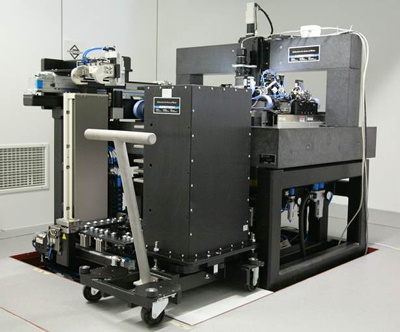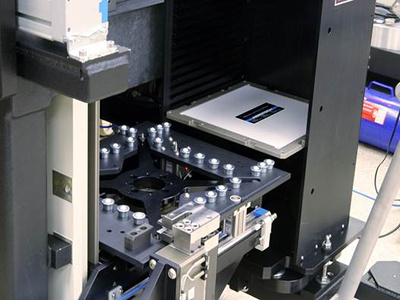ROB digitization facility
archive (restricted access only)
 A digitization and archiving facility has been created at the ROB under the Belgian D4A project (Digital Access to Aerial- and Astro-photographic Archives) that aims to digitise the astro-photographic collections of ROB, the aerial-photographic collections of the National Geographic Institute of Belgium, the Belgian Royal Museum of Central Africa and those of the DI07 project, also including the photographic collections of the Royal Institute of the Art Patrimonium. The new technology ROB digitizer uses specific optics, a diffuse illumination and nanotechnology mechanics to create a computer readable digital copy, with an unprecedented geometric accuracy, of the analogue sky images archived on the photographic plates. These digital images allow for an automated extraction of the positions of the celestial objects archived on the plates.
A digitization and archiving facility has been created at the ROB under the Belgian D4A project (Digital Access to Aerial- and Astro-photographic Archives) that aims to digitise the astro-photographic collections of ROB, the aerial-photographic collections of the National Geographic Institute of Belgium, the Belgian Royal Museum of Central Africa and those of the DI07 project, also including the photographic collections of the Royal Institute of the Art Patrimonium. The new technology ROB digitizer uses specific optics, a diffuse illumination and nanotechnology mechanics to create a computer readable digital copy, with an unprecedented geometric accuracy, of the analogue sky images archived on the photographic plates. These digital images allow for an automated extraction of the positions of the celestial objects archived on the plates.The value of photographic plates
Reduction of the data
 The astrometric reduction of the photographic plate images consists of extracting the positions of the heavenly objects visible on the plates and transforming these plate positions into astrometric positions on the celestial sphere. The use of a computer readable digital copy of the photographic images automates the extraction process and improves the accuracy of the extracted plate positions. Unfortunately, the digitization process introduces errors due to the illumination, the electronics and the optical distortion of the objective/detector unit. As the optical distortion caused by the objective/detector unit of the digitizer is stable in time, the induced systematic error can be corrected. In addition, the telescope optics and the Earth's atmosphere deform the positions, shape and brightness of the images of the objects on plates. These are usually corrected, using a distortion model determined by measuring the plate positions of the stars of a well-known open star cluster (like the Pleiades or Praesepe). Astrometric reduction is needed to determine the center of the figure of the observed natural satellites and of the reference stars visible on the same photographic exposure. In particular, as the partly resolved images of many natural satellites are far from spherical due to an inhomogeneous albedo and to their often only partial illumination by the Sun (similar to the well known phase figures of our Moon), the determination of the center of the figure is often hard to fix.
The astrometric reduction of the photographic plate images consists of extracting the positions of the heavenly objects visible on the plates and transforming these plate positions into astrometric positions on the celestial sphere. The use of a computer readable digital copy of the photographic images automates the extraction process and improves the accuracy of the extracted plate positions. Unfortunately, the digitization process introduces errors due to the illumination, the electronics and the optical distortion of the objective/detector unit. As the optical distortion caused by the objective/detector unit of the digitizer is stable in time, the induced systematic error can be corrected. In addition, the telescope optics and the Earth's atmosphere deform the positions, shape and brightness of the images of the objects on plates. These are usually corrected, using a distortion model determined by measuring the plate positions of the stars of a well-known open star cluster (like the Pleiades or Praesepe). Astrometric reduction is needed to determine the center of the figure of the observed natural satellites and of the reference stars visible on the same photographic exposure. In particular, as the partly resolved images of many natural satellites are far from spherical due to an inhomogeneous albedo and to their often only partial illumination by the Sun (similar to the well known phase figures of our Moon), the determination of the center of the figure is often hard to fix.
Necessary means to undertake the astrometric reduction
The ROB digitizer
 The digitisation process introduces errors due to the illumination, the electronics and the optical distortion of the objective/detector unit. To remove the first two, the raw images need a correction for flatness and darkness. The current optical system consists of a BCi4 CMOS camera from C-Cam Vector International, with a 9mm by 7mm non-cooled Ibis 4 digital detector of 1280 by 1024 pixels of 7µm x 7µm, mounted on a Schneider Xenoplan telecentric 1:1 objective. This objective/detector unit creates a digital copy of the photographic plate of about 3620dpi. The digitization process is done in a step and stare mode. Because the digital distortion of the current objective/detector unit rises to 3µm at a distance of 3.5mm from the optical axis, the digitization process uses increments of 5mm in both directions of the XY-table axes. As this optical distortion caused by the objective/detector unit of the digitiser is stable in time, the extracted plate positions can be corrected for this systematic error. Software was developed at the ROB for the automation of the step-and-stare digitization process, for the processing of the raw images, for the darkness and flatness of field corrections, for creating digital images in TIFF and FITS formats, and for the determination of the parameters of the correction model for the optical distortion caused by the objective/detector unit of the digitizer. Thanks to a partnership with the United States Naval Observatory (USNO), the ESPaCE project benefits from a large collection of high quality photographic plates of the planetary system that have been obtained between 1926 and 1998. In particular, it contains hundreds of observations of natural satellites of Mars, Jupiter and Saturn, the major targets of the today's space programs. The ROB digitisation facility will digitize all these photographic plates. The data will be used to provide new ephemeris kernels for these natural satellites. Thereafter, all data will be published in refereed journals and made accessible worldwide through a proper astrometric database.
The digitisation process introduces errors due to the illumination, the electronics and the optical distortion of the objective/detector unit. To remove the first two, the raw images need a correction for flatness and darkness. The current optical system consists of a BCi4 CMOS camera from C-Cam Vector International, with a 9mm by 7mm non-cooled Ibis 4 digital detector of 1280 by 1024 pixels of 7µm x 7µm, mounted on a Schneider Xenoplan telecentric 1:1 objective. This objective/detector unit creates a digital copy of the photographic plate of about 3620dpi. The digitization process is done in a step and stare mode. Because the digital distortion of the current objective/detector unit rises to 3µm at a distance of 3.5mm from the optical axis, the digitization process uses increments of 5mm in both directions of the XY-table axes. As this optical distortion caused by the objective/detector unit of the digitiser is stable in time, the extracted plate positions can be corrected for this systematic error. Software was developed at the ROB for the automation of the step-and-stare digitization process, for the processing of the raw images, for the darkness and flatness of field corrections, for creating digital images in TIFF and FITS formats, and for the determination of the parameters of the correction model for the optical distortion caused by the objective/detector unit of the digitizer. Thanks to a partnership with the United States Naval Observatory (USNO), the ESPaCE project benefits from a large collection of high quality photographic plates of the planetary system that have been obtained between 1926 and 1998. In particular, it contains hundreds of observations of natural satellites of Mars, Jupiter and Saturn, the major targets of the today's space programs. The ROB digitisation facility will digitize all these photographic plates. The data will be used to provide new ephemeris kernels for these natural satellites. Thereafter, all data will be published in refereed journals and made accessible worldwide through a proper astrometric database.
For any information regarding the DIGIT-project , please contact :
Dr Anatoliy Ivantsov
tel : +32 2 373 02 26
mail : a.ivantsov (at) oma.be
Joan Vandekerckhove
tel : +32 2 373 02 90
mail : j.vandekerckhove (at) oma.be